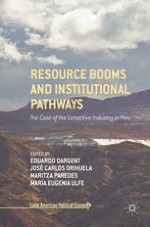2017 | Buch
Resource Booms and Institutional Pathways
The Case of the Extractive Industry in Peru
herausgegeben von: Eduardo Dargent, José Carlos Orihuela, Maritza Paredes, María Eugenia Ulfe
Verlag: Springer International Publishing
Buchreihe : Latin American Political Economy
